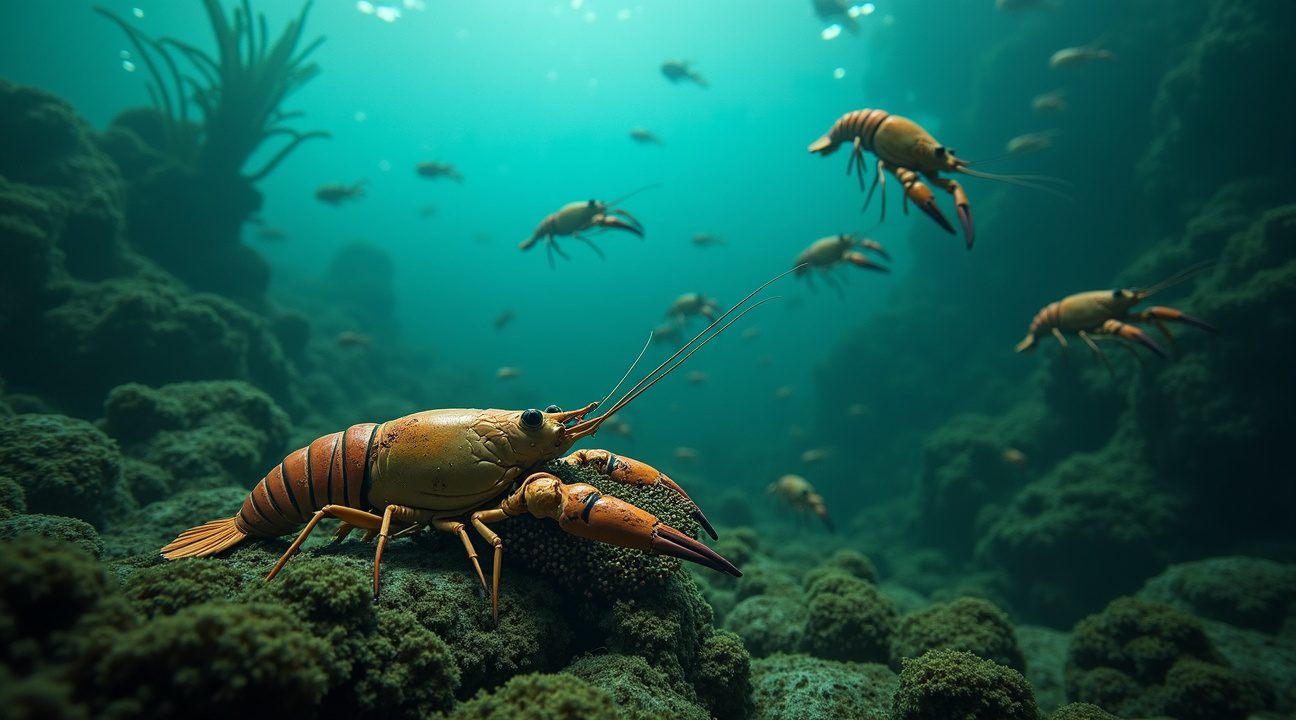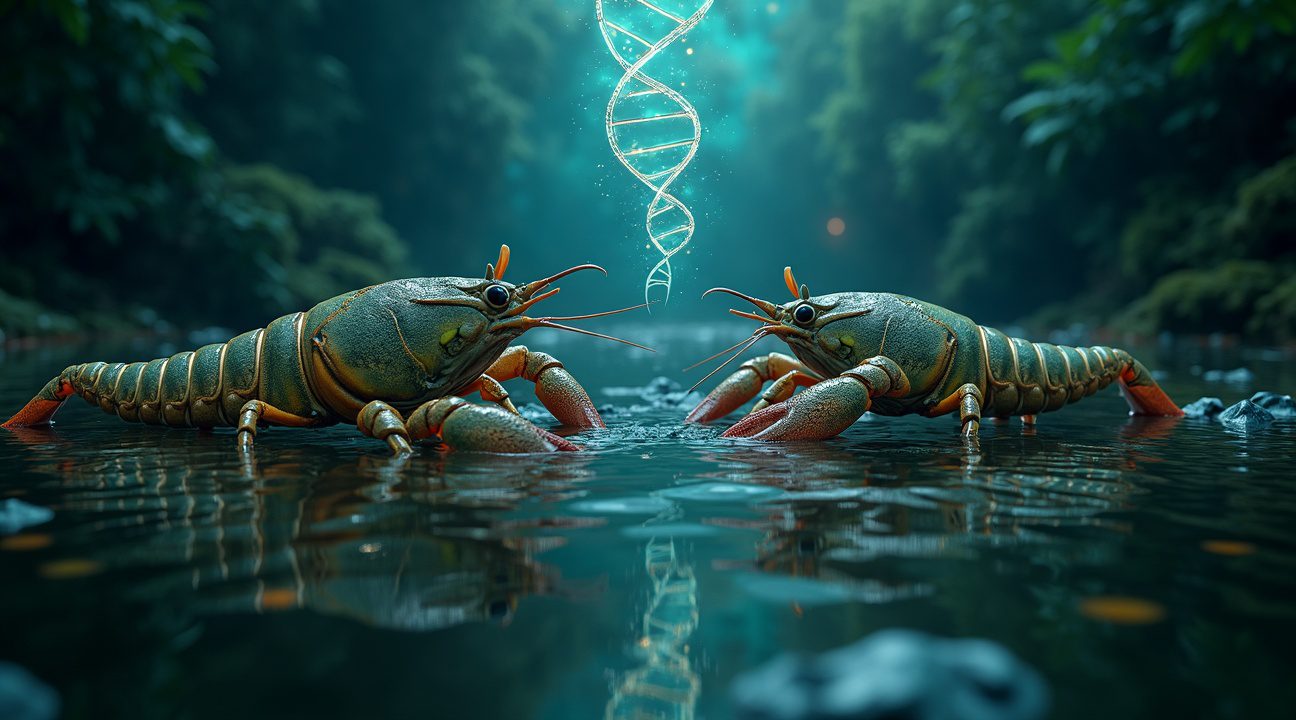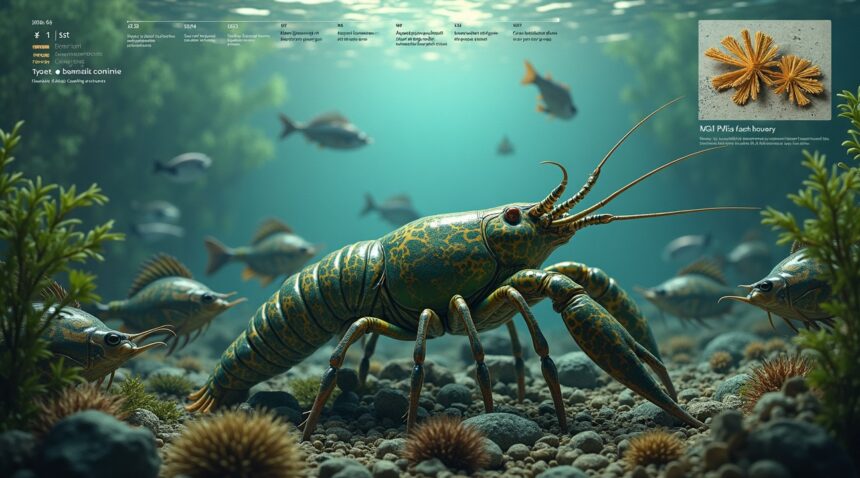The marbled crayfish represents one of nature’s most extraordinary reproductive anomalies, emerging from a single mutant individual in European aquariums during the 1990s to become the only known decapod crustacean capable of reproducing entirely without sexual partners.
This remarkable species can produce 200–700 genetically identical offspring per clutch that mature within weeks, allowing single individuals to rapidly establish massive clonal populations that overwhelm native ecosystems across multiple continents.
Key Takeaways
- Marbled crayfish are the only decapod crustaceans known to reproduce via parthenogenesis, generating offspring without fertilization or sexual partners.
- Each crayfish can produce 200–700 clones per clutch, which hatch within 2–3 weeks and reach sexual maturity in only six months.
- The species’ triploid chromosome structure means each individual carries three sets of chromosomes, enabling the creation of exact genetic replicas without genetic variation.
- A single marbled crayfish introduced to a new environment has the potential to form a large, self-sustaining colony, displacing native species through competition for food and habitat.
- Scientists utilize marbled crayfish as model organisms to study cancer, evolutionary development, and genetic degeneration theories like Muller’s ratchet due to their genetically identical makeup.
A Single Mutant Crayfish Is Cloning Itself Into Ecological Chaos
The marbled crayfish (Procambarus virginalis) emerged as a biological anomaly in European aquariums during the mid-1990s, representing what scientists now recognize as one of nature’s most remarkable reproductive achievements. This species likely descended from a single mutant individual of Procambarus fallax, creating an entirely new evolutionary lineage through a spontaneous genetic accident.
What makes this crayfish extraordinary is its status as the only known decapod crustacean capable of parthenogenesis—reproduction without sexual partners. Unlike traditional crayfish that require male and female pairs to produce offspring, every marbled crayfish is female and can lay viable eggs without any fertilization. I find this reproductive strategy fascinating because it mirrors scenarios scientists explore when considering genetic replication possibilities in other species.
Rapid Colonization Through Clonal Reproduction
A single marbled crayfish possesses the ability to rapidly colonize entire freshwater ecosystems through its clonal reproduction method. Each individual can produce dozens of genetically identical offspring multiple times per year, creating exponential population growth that traditional sexually reproducing species cannot match. This reproductive advantage allows the species to establish dense populations in new habitats within remarkably short timeframes.
The ecological implications prove severe as these clonal armies outcompete native species for resources and habitat space. Unlike sexually reproducing populations that require time to find mates and establish breeding pairs, each marbled crayfish functions as a complete reproductive unit. This eliminates the typical bottlenecks that limit population expansion in other aquatic species.
The species has transformed from a curiosity in European pet stores into a serious invasive threat across multiple continents. Madagascar has experienced particularly devastating impacts, where marbled crayfish populations have exploded throughout the island’s freshwater systems. European rivers and lakes face similar challenges as these clonal populations establish permanent footholds in previously unoccupied habitats.
Scientists worry about the long-term consequences of this reproductive strategy spreading to other crustacean species. The genetic mechanisms that enable parthenogenesis in marbled crayfish could potentially transfer to related species through hybridization events. Such scenarios would create additional clonal lineages with similar invasive potential, further disrupting aquatic ecosystems worldwide.
The marbled crayfish phenomenon demonstrates how single genetic mutations can trigger cascading ecological changes. Much like how researchers study unusual marine species to understand biological diversity, this crayfish offers insights into alternative reproductive strategies and their environmental consequences.

How Marbled Crayfish Create Armies of Genetic Clones in Weeks
Marbled crayfish accomplish this remarkable feat through a reproductive process called apomictic parthenogenesis. This scientific term describes a unique biological mechanism where eggs undergo normal cell division, specifically mitosis, and develop into fertile offspring without requiring sperm fertilization. I find this process fascinating because it essentially allows a single female to become an entire population generator.
Each marbled crayfish demonstrates incredible reproductive capacity by producing between 200 to 700 eggs per clutch. These eggs aren’t just numerous – they’re genetically identical to both their mother and each other, creating perfect genetic copies. The speed of this cloning process proves equally impressive, with eggs hatching in just 2 to 3 weeks under favorable conditions.
The Clone Development Timeline
The newly hatched offspring follow a predictable development pattern that maximizes their survival chances. Young crayfish remain attached to their mother for approximately 26 days, during which time they receive protection and learn essential survival behaviors. After this protective period ends, they become independent and begin their own lives.
Sexual maturation occurs rapidly in marbled crayfish, with individuals reaching reproductive capability in about six months. This quick development cycle allows for frequent reproductive events throughout their lifespan. Scientists have observed that this accelerated timeline creates opportunities for exponential population growth in surprisingly short periods.
The implications of this cloning ability extend far beyond simple reproduction. When marbled crayfish establish themselves in new environments, they can quickly overwhelm local ecosystems through sheer numbers. Each individual carries identical genetic material, which means the entire population shares the same strengths and weaknesses. While this genetic uniformity can lead to rapid colonization, it also creates vulnerabilities to diseases or environmental changes that affect their specific genetic makeup.
These reproductive capabilities present serious concerns for biodiversity conservation. Native species often struggle to compete with the rapidly expanding marbled crayfish populations. The clones consume similar food sources, occupy comparable habitats, and reproduce far more efficiently than most native freshwater species. This competitive advantage frequently results in:
- Displacement of indigenous species
- Disruption of established ecological relationships
- Changes in local biodiversity
Ecosystem balance suffers when genetically identical swarms dominate waterways. The study of genetics shows that healthy ecosystems depend on genetic diversity to maintain stability. Marbled crayfish populations lack this diversity by design, creating potential cascade effects throughout their adopted environments. Local food webs, predator-prey relationships, and nutrient cycling patterns all face disruption when these clone armies establish dominance in previously balanced aquatic systems.
https://www.youtube.com/watch?v=EQODFOlQAOE

The Genetic Mystery Behind Triple Chromosomes and Perfect Copies
Marbled crayfish present one of nature’s most fascinating genetic puzzles through their triploid structure, carrying three complete sets of chromosomes instead of the typical two found in most organisms. This unusual configuration likely arose through autopolyploidisation, a spontaneous process where chromosomes doubled within a single organism without external fertilization. The result creates a living laboratory where every individual represents an identical genetic copy of its parent.
Understanding the Clone Factory Mechanism
The triploid nature of these crayfish eliminates the need for sexual reproduction entirely. Each marbled crayfish functions as a biological photocopier, producing offspring that share 100% of their genetic material. This creates populations where thousands of individuals can trace their lineage back to a single ancestor, forming massive colonies of genetic twins. Scientists find this phenomenon particularly valuable because it removes the genetic variation typically introduced through sexual reproduction, allowing researchers to study pure genetic effects without interference from genetic shuffling.
Research Applications and Scientific Breakthroughs
Researchers leverage marbled crayfish as living models to investigate Muller’s ratchet, a critical evolutionary concept where asexual populations gradually accumulate harmful mutations across generations. Without genetic recombination to repair damaged genes, these populations face potential genetic deterioration over time. Scientists track how mutations build up in clonal populations, providing insights into evolutionary dead ends and adaptation limits.
The parallels between marbled crayfish colonies and cancer cell development have opened new avenues for biomedical research. Both systems involve rapid clonal expansion where genetic copies multiply without sexual reproduction. Cancer cells, like these crayfish, can accumulate mutations as they divide, and studying the crayfish model helps researchers understand how clonal populations adapt and survive despite genetic constraints.
Marbled crayfish colonies also serve as natural experiments in population genetics. Scientists can:
- Observe how identical organisms respond to environmental pressures
- Track the emergence of new mutations in real-time
- Study adaptation patterns without the complexity of genetic variation
This research contributes to a broader understanding of asexual evolution, helping explain how some species thrive despite abandoning sexual reproduction.
The genetic uniformity of marbled crayfish populations creates unprecedented opportunities for controlled scientific studies. Researchers can introduce specific environmental changes and observe consistent responses across genetically identical individuals, eliminating variables that typically complicate biological research. This makes marbled crayfish invaluable for studies ranging from toxicology testing to climate change adaptation research.

Why Most Crayfish Still Need Partners While Marmorkrebs Don’t
The vast majority of crayfish species rely on traditional sexual reproduction, requiring both males and females to create offspring. This process ensures genetic diversity within populations, giving them better chances of surviving environmental changes and diseases. Sexual reproduction has served crayfish well for millions of years, creating the genetic variation that allows species to adapt and evolve.
The Rare Ability of Facultative Parthenogenesis
Some crayfish species possess a remarkable backup plan called facultative parthenogenesis. The spiny-cheek crayfish (Orconectes limosus) can switch to asexual reproduction when males aren’t available, though this ability comes with significant limitations. These species produce fewer offspring through parthenogenesis, and the resulting progeny typically show reduced fitness compared to sexually produced young. This reproductive strategy serves as an emergency measure rather than a primary reproduction method.
Marmorkrebs: The Exception That Proves the Rule
Marbled crayfish stand apart as obligately parthenogenetic, meaning they can only reproduce asexually. Unlike their facultative cousins, marmorkrebs have perfected the cloning process, producing large numbers of viable offspring that match their mother’s genetic makeup exactly. This reproductive efficiency creates an extraordinary ecological advantage, allowing single individuals to establish entire populations without requiring a mate.
Parthenogenesis remains exceptionally rare among animals, particularly within decapod crustaceans like crayfish, lobsters, and crabs. Scientists have documented this phenomenon in only a handful of species across the entire animal kingdom. The evolution of obligate parthenogenesis in marbled crayfish represents a unique biological breakthrough that has captured researchers’ attention worldwide.
The reproductive differences between marmorkrebs and other crayfish species create vastly different ecological impacts. While sexually reproducing crayfish need established populations of both sexes to colonize new habitats, a single marbled crayfish can establish a thriving colony anywhere conditions permit. This ability makes them formidable invaders, capable of rapidly overwhelming native ecosystems. Traditional crayfish species face natural reproductive bottlenecks that limit their spread, but marmorkrebs bypass these constraints entirely.
Understanding these reproductive differences helps explain why marbled crayfish pose such a significant threat to aquatic ecosystems. Their unique cloning ability, combined with rapid growth rates and environmental tolerance, creates the perfect storm for biological invasion. While genetic research continues advancing in various fields, the marbled crayfish phenomenon demonstrates how nature occasionally develops its own extraordinary reproductive solutions.
The contrast between marmorkrebs and traditional crayfish reproduction highlights the remarkable diversity of life strategies that evolution can produce. Most crayfish maintain the tried-and-true method of sexual reproduction, while marbled crayfish have evolved into nature’s most efficient freshwater cloning machines.
Sources:
Big Think, “The marbled crayfish has been cloning itself for 30 years”
Neinvasives.com, “Marbled Crayfish”
PMC/NCBI, “A Novel Reproductive Mode in Decapod Crustaceans”
KMAE Journal, “Different aspects of reproduction strategies in crayfish”
Nature, “Parthenogenesis in an outsider crayfish”
WhyEvolutionIsTrue.com, “A parthenogenetic crayfish reproduces without sex”
Wikipedia, “Marbled crayfish”


